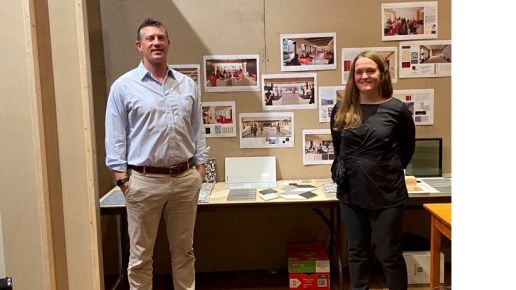Jonathan Steels and Sara Navrady
Meet two important members of the team working on the College’s new building: Jonathan Steels is Trinity’s Assistant Provost and one of the staff leads on the College’s Building Project. Sara Navrady is an architect with Mecanoo Architecten, the firm designing Trinity’s new student residence and academic building—the Lawson Centre for Sustainability—in partnership with Toronto firm RDH Architects Inc. (RDHA).
- Trinity’s Integrated Sustainability Initiative and our new building, the Lawson Centre for Sustainability, which will open in 2024, have been described as transforming the College into a “living lab” environment. What exactly does that mean?
JS: This is a broad-reaching concept that will be totally transformative to Trinity and well beyond—at both a macro community engagement level to hands-on study by individual students. At the macro level, this building will ingrain sustainability into the ethos and consciousness of both residents and day-users. Its timber construction, vast natural light, welcoming staircases and special features such as the community kitchen and urban agriculture operation will fundamentally change the user experience, fostering a more sustainable way of being and healthier, happier residents. This could mean awareness around the consumption of the food production facilitated by the Lawson Centre, using stairs over elevators, or flushing a toilet that is using reclaimed water—and we can measure and report on the impact of various aspects by comparing user experience before and after occupancy. At the more hands-on level, it means students engaging actively in sustainability learning, study and research in a manner facilitated by the structure and associated teaching tools and curriculum. Again, this could take a large-scale form, such as all students eating and learning about the food we grow, or it could be an individual student conducting a study of nutrient density of food grown on the roof versus the ground, as it relates to growing conditions in each locale.
SN: The idea of a living lab can be interpreted in many ways, but for the Lawson Centre for Sustainability it refers to the way the building can serve as a real-time educational tool around building performance and the symbiotic roles between building and user in relation to sustainability and user well-being. By increasing awareness around users’ behaviour and their impact on the building performance, the building serves as a teaching tool for various aspects of sustainability and how day-to-day habits can contribute to living in a more sustainable way. Tools that help facilitate this include the building dashboard, which displays energy use in the building, letting students see how small adjustments can reduce energy and water consumption. Other ways in which students become active participants is in the educational program designed around the community kitchen and urban farm, which enables students to have hands-on education around food production and nutrition.
- Are there other buildings you look to for inspiration in charting this course for the College, or is this uncharted territory?
JS: A bit of both. There are some amazing structures out in the world that serve as advanced models and we have learned a lot from them, and yet this building will be at the forefront, continuing to advance this area, particularly in North America and in the Toronto climate. To inform development of the Lawson Centre we did extensive study of other buildings, particularly those with comparable major building systems such as mass timber and geothermal. We also visited places and spaces with features or aspects of features we are incorporating—for example, the urban agriculture operation at Ryerson University and the inspiring grounds and rainwater recapture gardens at Ronald McDonald House in Toronto. In the Netherlands we visited the Circl building, made of mass timber and with inspirational “circular” ethos built into operations about factors such as building materials and utilities; they also have an impressive garden operation and canning kitchen for the food they grow. The CIRS (Centre for Interactive Research on Sustainability) has also served as an early model and benchmark, and is an impressive structure at the University of British Columbia.
SN: Mecanoo approaches every project with a unique perspective, using our philosophy of People, Place, Purpose to unlock a project specific response. This is always informed by lessons learned along the way, so in that sense certain “ingredients” take inspiration from other buildings. One of our previous student housing projects, the key workers’ housing for the University of Cambridge, also targeted high sustainability goals, while combining materials such as brick and wood in a playful way. However, the way it is articulated for Trinity is responding to the unique conditions for the building, using locally sourced brick and limestone. The varying façades around the building help articulate the mixed-use activities in the program.
- In what ways has the COVID-19 pandemic affected the design and construction of Trinity’s new building?
JS: From the earliest days of design, we contemplated generous common spaces, food service facilities and residence areas suitable to accommodation of COVID-19 and possible future challenges of this nature. In terms of our process of design through the pandemic, it certainly slowed us down, but we worked closely with various experts and governance bodies to carefully assess risk while taking each step forward thoughtfully. Overall, this careful thought benefits the design and associated decisions, and we will have a beautiful, high-functioning building as a result.
SN: Francine Houben [creative director of Mecanoo] speaks about how buildings should be prepared for unpredictable change, and the pandemic is a good example of this. I think one of the design aspects that translates well to a post-pandemic reality is creating a variety of spaces for different working and living conditions. We have also planned generous circulation areas that can serve as informal meeting spaces with room for distancing should another pandemic occur. The café design is also factoring in current pandemic-related protocols for hygiene, with the possibility to adapt as operations adjust in the future.
- What features of the Lawson Centre are you most excited about?
JS: I’m an avid gardener and cook. I’m also a curious hands-on learner and a social person. For me, the urban agriculture operation is incredibly exciting: It underpins the delivery of fresh, nutritious food for our students, and it has the potential to engage the whole broader Trinity community along the way, from planning and caring for the garden, to studying it, to harvesting, cooking and eating. It also serves as a community model for what is possible, and will allow us to engage a much broader community beyond the walls of Trinity. I’m excited to watch the program grow and creatively adapt over the coming years, and I’m excited for all the ways people will be engaged, especially students.
SN: I love to cook so I’m personally excited for the many ways the Centre celebrates food, from an educational and social aspect. The café will really become a space for the Trinity community to come together around food in a new, cozy atmosphere. The community kitchen and urban farm build on the success of the existing campus farm operations, enabling students to get hands-on with how food is grown and prepared. This enriches their university experience, both educationally and by enhancing student wellbeing. I also love the views from the informal study areas into the new landscaped courtyards. Each area has a different view to the new gardens—in my university days I would have loved such a space to study!
- What roles can alumni play in bringing this new building to life?
JS: The Lawson Centre will be transformational for Trinity in so many ways—and the tremendous generosity of Joannah and Brian Lawson is allowing us to turn leading-edge vision into bricks-and-mortar reality. There will be innumerable ways for alumni to be involved and engaged in the new building: for example, rolling up their sleeves to help with the urban agriculture operation, or attending talks, workshops and events. We are really excited about the huge array of events possible with the Community Kitchen—lectures, workshops, and activities focused on food and sustainability, with all possible combinations of attendees, from alumni to students to members and groups from the broader community. We will be conducting building and systems educational sessions and tours, and welcome alumni engagement in all aspects of this work. We are also excited for alumni to come and enjoy the beautiful physical space—the exposed structural timber, local limestone and brick; the thoughtfully curated interior finishes; the spectacular top-floor teaching and event space; and the cozy fireplace lounge. They might have a meal in the spectacular new dining facility, take a stroll of the extensive grounds and gardens, or relax in the new foyer space after an event at the George Ignatieff Theatre.
SN: Something that the design team noticed from project start was the strength of the Trinity community and the high degree of alumni excitement about the Lawson Centre. Designing for the entire Trinity community was one of the key objectives for the project, in creating open and informal areas for students and alumni alike to meet. We are all really excited about the event pavilion as a new venue for alumni events, and areas like the café and community kitchen will create spaces for the entire community to enjoy. At the Library of Birmingham, another project from Mecanoo, the community was so committed to the rooftop gardens they formed a volunteer committee to help with the gardening—if there are some hard -core gardeners at Trinity I’m sure there could be a new alumni gardening club on the horizon!
Bonus question: What have you learned about the Trinity community through your involvement in designing our new building?
JS: Just how deeply committed and caring the extended Trinity community is—and the informed, optimistic and future-oriented collective ethos that predominates. Trinity attracts top students, nationally and internationally, and this building will literally provide an applied foundation for all Trinity students in core principles of sustainability, fostering the values most needed in tomorrow’s leaders to ensure a bright future for humanity and the planet.
SN: I think the process has shown Trinity’s commitment to promoting issues that are important for the future success of Trinity students as citizens—within both Trinity and the community at large. Sustainability is at a critical point, and the Lawson Centre marks a new chapter for Trinity to create a landmark that exemplifies the values being taught at the College. At the same time, it will create meaningful spaces for dialogue among students, teachers, visiting experts and the broader community. In this sense it becomes a forum for dialogue not only by providing spaces for lectures and events, but by the dynamic range of activities and through it becoming a tool to exemplify this commitment. Student wellness is another aspect of sustainability that was discussed extensively in the development process. We have strived to create a building that offers the warmth of timber with plenty of natural light and views to nature, and creates a holistic and nurturing place to study, socialize and live.

